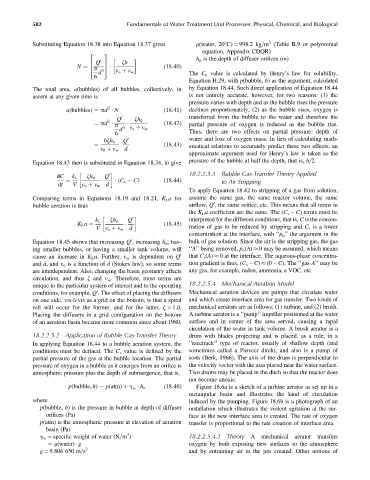Page 627 - Fundamentals of Water Treatment Unit Processes : Physical, Chemical, and Biological
P. 627
582 Fundamentals of Water Treatment Unit Processes: Physical, Chemical, and Biological
3
Substituting Equation 18.38 into Equation 18.37 gives r(water, 208C) ¼ 998.2 kg=m (Table B.9 or polynomial
equation, Appendix CDQR)
2 3
h o is the depth of diffuser orifices (m)
0 zh
6 Q 7
p 3 5
N ¼ 4 (18:40)
d v o þ v w The C s value is calculated by Henry’s law for solubility,
6
Equation H.29, with p(bubble, h) as the argument, calculated
The total area, a(bubbles) of all bubbles, collectively, in by Equation 18.44. Such direct application of Equation 18.44
ascent at any given time is is not entirely accurate, however, for two reasons: (1) the
pressure varies with depth and as the bubble rises the pressure
2
a(bubbles) ¼ pd N (18:41) declines proportionately, (2) as the bubble rises, oxygen is
transferred from the bubble to the water and therefore the
Q 0
2 zh 0
¼ pd p (18:42) partial pressure of oxygen is reduced as the bubble rise.
d 3 v o þ v w
6 Thus, there are two effects on partial pressure: depth of
Q 0 water and loss of oxygen mass. In lieu of calculating math-
6zh o
(18:43)
¼ ematical relations to accurately predict these two effects, an
v 0 þ v w d
approximate argument used for Henry’s law is taken as the
pressure of the bubble at half the depth, that is, h=2.
Equation 18.43 then is substituted in Equation 18.34, to give
18.2.2.5.3 Bubble Gas-Transfer Theory Applied
dC k L zh o Q 0
(C s C) (18:44) to Air Stripping
dt V v o þ v w d
¼
To apply Equation 18.42 to stripping of a gas from solution,
Comparing terms in Equations 18.19 and 18.21, K L a for assume the same gas, the same reactor volume, the same
bubble aeration is thus airflow, Q , the same orifice, etc. This means that all terms in
0
the K L a coefficient are the same. The (C s – C) terms must be
k L zh o Q 0 interpreted for the different conditions, that is, C is the concen-
(18:45)
K L a ¼ tration of gas to be reduced by stripping and C s is a lower
V v o þ v w d
concentration at the interface, with ‘‘p o ’’ the argument in the
Equation 18.45 shows that increasing Q , increasing h o , hav- bulk of gas solution. Since the air is the stripping gas, the gas
0
ing smaller bubbles, or having a smaller tank volume, will ‘‘A’’ being removed, p o (A) 0 may be assumed, which means
cause an increase in K L a. Further, v w is dependent on Q 0 that C s (A) 0 at the interface. The aqueous-phase concentra-
and d, and v o is a function of d (Stokes law), so some terms tion gradient is thus, (C s – C) (0 – C). The ‘‘gas-A’’ may be
are interdependent. Also, changing the basin geometry affects any gas, for example, radon, ammonia, a VOC, etc.
circulation, and thus z and v w . Therefore, most terms are
18.2.2.5.4 Mechanical Aeration Model
unique to the particular system of interest and to the operating
conditions, for example, Q . The effect of placing the diffusers Mechanical aeration devices are pumps that circulate water
0
on one side, vis-à-vis as a grid on the bottom, is that a spiral and which create interface area for gas transfer. Two kinds of
roll will occur for the former, and for the latter, z > 1.0. mechanical aerators are as follows: (1) turbine, and (2) brush.
Placing the diffusers in a grid configuration on the bottom A turbine aerator is a ‘‘pump’’ impeller positioned at the water
of an aeration basin became more common since about 1980. surface and in center of the area served, causing a rapid
circulation of the water in tank volume. A brush aerator is a
18.2.2.5.2 Application of Bubble Gas-Transfer Theory drum with blades projecting and is placed, as a rule, in a
In applying Equation 18.44 to a bubble aeration system, the ‘‘racetrack’’ type of reactor, usually of shallow depth (and
conditions must be defined. The C s value is defined by the sometimes called a Pasveer ditch), and also is a pump of
partial pressure of the gas at the bubble location. The partial sorts (Berk, 1966). The axis of the drum is perpendicular to
pressure of oxygen in a bubble as it emerges from an orifice is the velocity vector with the axis placed near the water surface.
atmospheric pressure plus the depth of submergence, that is, Two drums may be placed in the ditch so that the reactor does
not become anoxic.
(18:46)
p(bubble, h) ¼ p(atm) þ g h o Figure 18.6a is a sketch of a turbine aerator as set up in a
w
rectangular basin and illustrates the kind of circulation
where induced by the pumping. Figure 18.6b is a photograph of an
p(bubble, h) is the pressure in bubble at depth of diffuser installation which illustrates the violent agitation at the sur-
orifices (Pa) face as the new interface area is created. The rate of oxygen
p(atm) is the atmospheric pressure at elevation of aeration transfer is proportional to the rate creation of interface area.
basin (Pa)
3
g w ¼ specific weight of water (N=m ) 18.2.2.5.4.1 Theory A mechanical aerator transfers
¼ r(water) g oxygen by both exposing new surfaces to the atmosphere
2
g ¼ 9.806 650 m=s and by entraining air in the jets created. Other notions of

